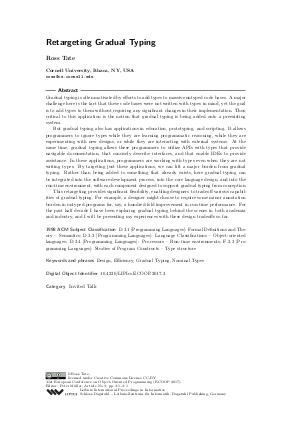Retargeting Gradual Typing (Invited Talk)
Author Ross Tate
-
Part of:
Volume:
31st European Conference on Object-Oriented Programming (ECOOP 2017)
Part of: Series: Leibniz International Proceedings in Informatics (LIPIcs)
Part of: Conference: European Conference on Object-Oriented Programming (ECOOP) - License:
 Creative Commons Attribution 3.0 Unported license
Creative Commons Attribution 3.0 Unported license
- Publication Date: 2017-06-16
File

PDF
LIPIcs.ECOOP.2017.3.pdf
- Filesize: 200 kB
- 1 pages
Document Identifiers
Subject Classification
Keywords
- Design
- Efficiency
- Gradual Typing
- Nominal Types
Metrics
- Access Statistics
-
Total Accesses (updated on a weekly basis)
0Document
0Metadata
Abstract
Gradual typing is often motivated by efforts to add types to massive untyped code bases. A major challenge here is the fact that these code bases were not written with types in mind, yet the goal is to add types to them without requiring any significant changes in their implementation. Thus, critical to this application is the notion that gradual typing is being added onto a preexisting system. But gradual typing also has applications in education, prototyping, and scripting. It allows programmers to ignore types while they are learning programmatic reasoning, while they are experimenting with new designs, or while they are interacting with external systems. At the same time, gradual typing allows these programmers to utilize APIs with types that provide navigable documentation, that concisely describe interfaces, and that enable IDEs to provide assistance. In these applications, programmers are working with types even when they are not writing types. By targeting just these applications, we can lift a major burden from gradual typing. Rather than being added to something that already exists, here gradual typing can be integrated into the software-development process, into the core language design, and into the run-time environment, with each component designed to support gradual typing from conception. This retargeting provides significant flexibility, enabling designers to tradeoff various capabilities of gradual typing. For example, a designer might choose to require some minor annotation burden in untyped programs for, say, a hundred-fold improvement in run-time performance. For the past half decade I have been exploring gradual typing behind the scenes in both academia and industry, and I will be presenting my experiences with these design tradeoffs so far.
Cite As Get BibTex
Ross Tate. Retargeting Gradual Typing (Invited Talk). In 31st European Conference on Object-Oriented Programming (ECOOP 2017). Leibniz International Proceedings in Informatics (LIPIcs), Volume 74, p. 3:1, Schloss Dagstuhl – Leibniz-Zentrum für Informatik (2017)
https://doi.org/10.4230/LIPIcs.ECOOP.2017.3
BibTex
@InProceedings{tate:LIPIcs.ECOOP.2017.3,
author = {Tate, Ross},
title = {{Retargeting Gradual Typing}},
booktitle = {31st European Conference on Object-Oriented Programming (ECOOP 2017)},
pages = {3:1--3:1},
series = {Leibniz International Proceedings in Informatics (LIPIcs)},
ISBN = {978-3-95977-035-4},
ISSN = {1868-8969},
year = {2017},
volume = {74},
editor = {M\"{u}ller, Peter},
publisher = {Schloss Dagstuhl -- Leibniz-Zentrum f{\"u}r Informatik},
address = {Dagstuhl, Germany},
URL = {https://drops.dagstuhl.de/entities/document/10.4230/LIPIcs.ECOOP.2017.3},
URN = {urn:nbn:de:0030-drops-72802},
doi = {10.4230/LIPIcs.ECOOP.2017.3},
annote = {Keywords: Design, Efficiency, Gradual Typing, Nominal Types}
}
